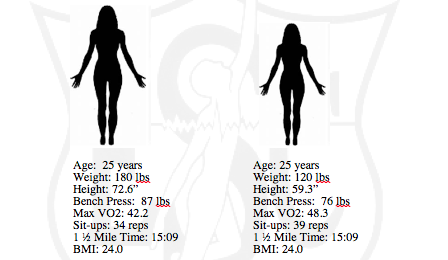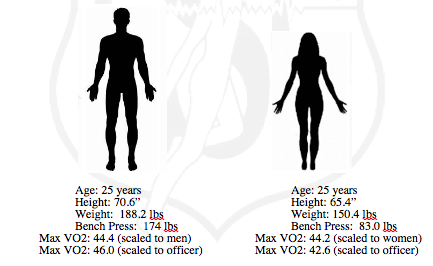Washington State Law Enforcement Physical Assessment Testing
Blake Surina
BODY DIMENSION SCALING
When measuring physical performance, it should be understood that smaller individuals are more metabolically active per pound than larger individuals. They can do more push-ups, and would require more oxygen consumption (MET’s) per pound to run the same pace as a similarly trained larger individual.

*Recommendation is to have separate standards for males and females, and allometrically scale results for females to the average weight of a female, and males to an average weight of a male.
The 56 kg world record holder in the combined clean and jerk and snatch lifts, can lift 5.45 times their body weight where the 105 kg lifter lifts 4.19 times their body weight, or 23% less on a strength to weight ratio basis. Shall a 105 kg world record holder be penalized with a “C” grade on his strength? In essence this is exactly what is being done when using a push-ups or pull-ups test to evaluate the strength between two competing and differently sized police officer candidates.
A simple law of physics says that a person who is twice the mass of another does not lift twice the weight, but 2/3rdof twice the weight with the same level of training. Using this 2/3rdexponential ratio all subjects can be fairly evaluated between one another.
MALE AND FEMALE
Many cities are seeking to have a police department that reflects the diversity of their community. At the same token cities do not want to give special preferences to one sex, age, sex or race. State and federal precedents require similar pass rates for males and females when performing testing. Since women are typically 40 pounds lighter, possess higher body fat percentages, and less upper body strength than their male counterparts, separate standards for strength exercises should be employed.
On the other hand, male and female candidates tested on a bicycle ergometer can reach the same weight to workload relationships when being evaluated. Since women are smaller (approximately 40 lbs), and are more active per pound, they can achieve the same work to weight ratios as their larger male counterparts.
Why then do the male aerobic performances exceed those of similarly trained females? The state winning times in the 2 mile run are always faster for men vs women in state championships. To have the Max VO2’s relate to the candidates running performance on a 1.5 mile run, the Max VO2 would need to be scaled to the average weight of the average officer, (men and women scaled to the same size). The difference between scaling by the average weight of a male or female, versus scaling their weight to the weight of the average human (regardless of sex) is the exact difference between the average times for the top 5 state winning 2 mile times between males and females.

Recommendations for testing officers for aerobic capacity to use allometric scaling of women to the average sized woman and men to the average sized man. Grading will be able to use the same scoring chart with measure work to weight for each candidate regardless of sex.
AGING
Older candidates seeking employment into a new department, (i.e. laterally transfer), are often under the same scoring charts for their physical assessments as younger entry-level officers. With over 30,000 assessments performed standards are created, taking into account the normal aging process for an officer.

Recommendations for testing older officers is to use allometric scaling of women to the average sized woman their age, and men to the average sized man their age. Grading will be able to use the scoring chart adjusted for the age of candidate.
Summary:
Physical assessments should be fair and equitable to every candidate, and the fittest candidates should be identified. This is to ensure that less fit candidates are not are not selected for service thereby putting themselves at increased risk of serious injury. The current physical assessments were constructed over a half a century ago, do not compensate for difference in the sex and age of a candidate, and handicap larger candidates because of a lack of allometric or body dimension scaling.
